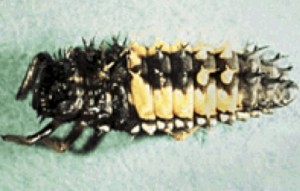
Brief: The green apple aphid complex (GAA), comprised of green (Aphis pomi) and spiria aphid (Aphis spiraecola), often develop in high numbers during the early summer. This event will occur during the flush growth of new shoots, often initiated after repeated rain events. Succulent foliage on which aphid feed provide an ample source of nitrogen for rapid aphid reproduction.
As of Friday, June 18th GAA were observed feeding on Gala fruit in commercial blocks with high populations developing in rapidly growing shoots.
During scouting efforts we’ve seen GAA populations explode during the past week. Shoots laden with aphids clinging to the undersides of new terminal leaves cause the leaves beneath to drip with ‘honeydew’. In years where populations are high, ‘honeydew’ droplets falling on fruitlets can lead to fruit russetting injury from aphid feeding. Although not expressed immediately, when aphids directly feed on fruit. pocking of the apple will appear later in the season, often showing up during storage, causing the fruit to become unmarketable.
Low rates of insecticides in the Neonicotinoid class (Admire Pro, Assail, Actara) will reduce aphid populations while maintaining higher levels of predatory beneficial insects. Conserving ladybird beetle adult and larva, syrphid and cecidomyiidae larva will reduce aphids as the season progresses and may reduce the need for additional applications later in the season.
Potato Leafhopper (PLH) adults have also descended into the Hudson Valley, arriving on thermals, now infesting terminal shoots. Low rates of Neonicotinoid insecticides applied at 7-14 days will provide translaminar (locally systemic) presence of the active ingredient to manage the nymph stage of these pests, providing the environment for continued terminal growth in young trees.

Introduction: The aphid complex appears to be erupting during the June hot and dry condition we’ve been experiencing this week. The green aphid complex include the apple aphid, Aphis pomi, and spirea aphid, Aphis spiraecola. Typically populations begin increasing from mid June into July. Both species appear to be building rapidly on growing terminals of apple with very high populations observed on succulent new foliage. The ability of these insects to produce live young partially accounts for the rapid buildup of aphid populations. Unlike some aphid species, which migrate to an alternate host during the summer, green apple aphid spends its entire life cycle on apple.
Nymphs and adults of draw sap from foliage of growing terminals and water sprouts. Aphid feeding causes leaf curl, often causing the growing tip to stunt shoot growth on newly planted trees. The excretion of honeydew, the excreted sap shunted from aphids has been observed falling onto fruit and foliage. The development of black sooty mold (Ascomycete fungi) which grow on a sugar substrate, causes russeted areas on the fruit around the stem in hot weather, very apparent on light colored cultivars like Golden Delicious.
Aphid scouting should begin in mid-June. Sampling 10 rapidly growing terminals from each of 5 trees throughout the orchard with management recommended if 30% of the terminals are infested with either or both species of aphid or if 10% of the fruits exhibit either aphids or honeydew. Important biological control predators that feed on aphids include the larvae of syrphid and cecidomyiid flies. These beneficial insects complete three generations yearly, during the summer.

The multi-coloured Asian lady beetle, Harmonia axyridis (Pallas) (MALB), is an invasive insect that has flourished in the Northeastern US. Its overwintering presence in homes can not be overstated. Introduced as a beneficial insect to manage the aphid complex, the beetle will follow suit and begin feeding heavily on the aphids.
Using LOW RATES of neonicotinoid insecticides as the aphid populations begin to develop. The goal is to maintain low levels of aphids and conserve the predators at equally low levels to reduce the impact of damage to fruit. For example, the use of Admire Pro 4.6SC at about 1/3 the high rate, such as 1 oz./A, providing a reduction of the aphids while having low impact on the beetle, will thus conserve the beneficial complex.



